A local photographer's expert tips for getting the best photos in Venice
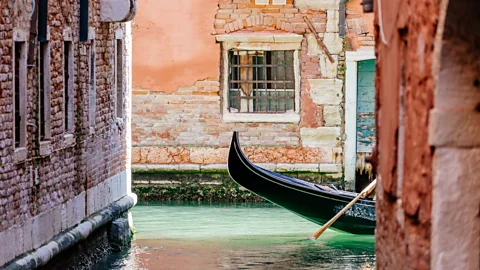
Getty photographer Stefano Mazzola offers the most photo-worthy ops in his native Venice, from the sea of parked gondolas in Bacino Orseolo to sunrises at Ponte dell'Accademia.
Ancient candy-coloured Venice, Italy, is among the world's most uniquely beautiful cities, and is also one of the most photographed. Millions gather each year to gaze at the gondolas gliding through its otherworldly canals as they pack themselves onto romantic bridges and throng its magnificent piazzas – all eager to get that one perfect picture in a picture-perfect place.
Overtourism is this gorgeous city's scourge, the SOS on the flip side of the postcard. So how to enjoy your visit and get great photos – without getting an elbow in the face or inconveniencing the locals?

The SpeciaList
Venetian born and bred Stefano Mazzola ran a restaurant before becoming a photographer. His photographs of everyday, non-touristy Venetian life have been featured in internationally renowned publications including The Guardian, The New York Times, National Geographic and Lonely Planet.
We spoke to Venetian native, Getty photographer Stefano Mazzola, for his niche take. His tip: visit the iconic wonders at dawn or after sunset, when the day trippers have fled, and then embrace Venice’s peculiarities. "Water is the crucial element," said Mazzola. "The tide comes in for six hours, it's slack for one hour, and then it ebbs for six hours… it's a city that changes every hour because of the changes in the water and the light."
Mazzola takes visitors on Venice photo walks to discover the city's most iconic treasures, as well as its exquisite quirks. "Yes, of course, go see the Basilica di San Marco, the Palazzo Ducale (Doge’s Palace), the prisons, Piazza San Marco," he advised. "But don't spend 10 hours [there]. Explore. Go for a walk. Get lost. Go get lost with your partner, with a friend. Stop every hour to have a glass of wine or a cicchetto [Venetian tapas] and keep walking… That's how you're going to discover the most hidden gems, the street corners, the most beautiful things."
Venice is a walkable jewel, its six sestieri (districts) easily crossed by foot or canal using one of the city's vaporetti (waterbuses). Here is photographer Stefano Mazzola's list of the most photo-worthy scenes in Venice.
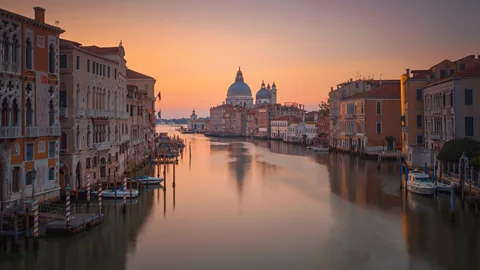 Cavan Images/Alamy
Cavan Images/Alamy1. Best for catching the sunrise: Ponte dell'Accademia
Photo-taking tips
Stefano Mazzola loves taking photos of Venice that capture all its moods – and thanks to its ever-changing water levels and constant stream of people, it has many. "Find a place, see if you like it," advises Mazzola. "Take the first photo without a subject; see if the light is good, if the settings are right. Then wait. Maybe a gondola will by. Maybe in two minutes, a woman with a beautiful yellow raincoat and a red umbrella will cross the bridge. Maybe in five minutes, a man will cross the bridge with a stunning dog. In Piazza San Marco, you can photograph different people every second, wearing different clothes."
"There are two Venices," said Mazzola. "The touristy Venice that runs from Piazza San Marco to the Rialto Bridge that’s invaded from 09:00 in the morning to 06:00 or 07:00 in the afternoon. [It’s], for me as a Venetian, unlivable. The real Venice, the one of the high quarters, is still gorgeous."
Getting an early start is the key to snapping great photos in this heavily touristed city – without someone’s head in the frame. Mazzola’s pick for experiencing daybreak is Ponte dell'Accademia.
The mammoth wooden structure arching across the Grand Canal is one of Venice's four principal bridges, and according to Mazzola, offers a unique view as the light shimmers over the rainbow-hued buildings.
"If you're on the Ponte dell'Accademia, looking towards the Grand Canal, Palazzo Cavalli-Franchetti is the first building on the left," said Mazzola. "You can get images at sunrise with the first rays of light on the Grand Canal and this amazing building on the left and the Basilica [di Santa Maria] della Salute on the right of the Grand Canal. It's lovely."
 EM_prize/Alamy
EM_prize/Alamy2. Best for observing gondolas and gondoliers: Bacino di San Marco and Bacino Orseolo
The gondolier – gondoliere/a in Italian – is an iconic figure yet shrouded in myth. If you want to get an unfettered look at gondolas, Mazzola suggests heading – once again, at dawn – to Bacino di San Marco, the city's main harbour on the lagoon, where gondolas park at night. "With the Palazzo Ducale behind you, you can shoot three, five, seven gondolas depending on how wide your lens is, with the Island of San Giorgio in the background," said Mazzola.
But to witness the gondoliers themselves in their natural state, Mazzola loves visiting Bacino Orseolo. "It's a minute away from Piazza San Marco," he said. "The gondolas that work in that area park there all night in that little basin. If you go in the morning at 07:30 or 08:00, you'll find 30, 35 gondolas all shuttered in the same place. The guys who clean them [start] taking off the tarps and cleaning the gondolas one by one. [It's] also lovely because the guys who are cleaning the gondolas will be chatting in Venetian. It's a welcoming place. It's a place where you see the real Venice."
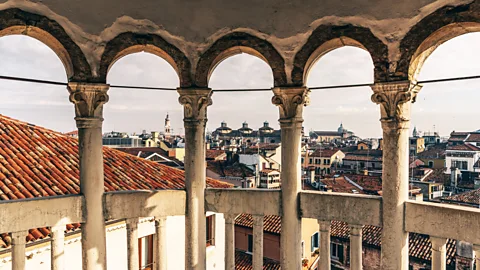 heinstirred/Getty Images
heinstirred/Getty Images3. Best for seeing the panorama of Venice: Scala Contarini del Bovolo
Carnevale in Venice
Venice is so beautiful you'll want to see it all at once. Mazzola's favourite place for seeing its most gasp-worthy city panorama is the Scala Contarini del Bovolo – an 80-step spiral staircase encased in a turret in the Palazzo Contarini del Bovolo.
The visual beauty – and photo ops – of Venice are even more spectacular during the weeks leading up to its world-famous masked Carnevale celebrations, when people wander the calle wearing elaborate maschere (masked costumes). "It's very nice to see the maschere inside the historic Caffé Florian," said Mazzola, referencing the iconic café on Piazza San Marco, dating to 1720. Another one of Mazzola's favourite Carnevale sights: "During the last two weeks of Carnevale, before sunset, the people in costume go to the Island of San Giorgio and pose for the photographers with Piazza San Marco and the Palazzo Ducale behind them," he said. "The light of the sunset softly colours everything."
But the already bursting-at-the-seams city becomes even more chaotic during Carnevale, so how to take great photos when you're buried in a sea of masked tourists? "When you're surrounded by people it becomes complex," itted Mazzola. "The only way is to photograph half-length from below with a beautiful building in the background." Mazzola also advised against coming to Venice during the last weekend before Martedi Grasso (Fat Tuesday) "Come to Venice during the other Carnival days."
"In Venetian, bovolo means spiral," explained Mazzola. "[The palace] is halfway between Piazza San Marco and the Rialto Bridge… and it's unique because this spiral staircase is fantastic. You walk up all these stairs which take you up to the panoramic terrace of this palace which [has] all these arches at 360 degrees, circular. You can see all of Venice."
The Palazzo Contarini del Bovolo is a 15th-Century building built by the noble Contarini family in the Venetian Gothic style, tucked away in a quiet side street near Campo Manin. "It's amazing for taking photos because you can take a shot of two arches with a slice of San Marco inside," said Mazzola. "Or two other arches that capture the Basilica dei Frari, and you can see all of Venice from up there. It's a beautiful hidden gem."
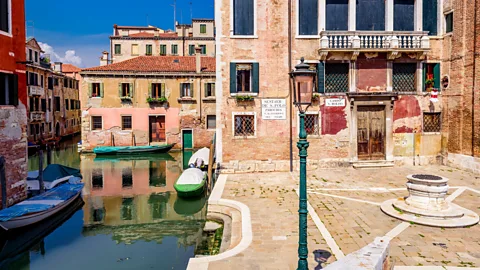 Image Professionals GmbH / Alamy Stock Photo
Image Professionals GmbH / Alamy Stock Photo4. Best for secret alleyways: i Sestieri di San Polo e Santa Croce
Some of Venice's greatest beauties lie in small details. During the day, while tourists swarm the city centre, Mazzola suggests crossing the Rialto Bridge and heading to the sestieri San Polo and Santa Croce.
"They're full of little labyrinths," Mazzola said. "In Venice, the word for street isn't via but calle, and this area is made of these tiny narrow streets. I can show people around for two hours, but we never get very far from where we started. And we never see the same place twice!"
The Sestieri di San Polo e Santa Croce are two bordering neighbourhoods rarely frequented by tourists and are home to medieval architecture and thriving fish, meat and green markets. "It's lovely because every two minutes you find this beautiful corner, this beautiful reflection or some crooked bridge, as gondolas are ing," said Mazzola. "At the border of San Polo and Santa Croce, there's a square that I think is marvellous; Campo San Boldo. [It's] been the subject of many paintings, many films… There's a well in the middle. There's a belltower that's missing the tip. There's a canal that runs along it with the [crooked] Ponte Storto bridge curving around… it's so beautiful. And almost no one goes there."
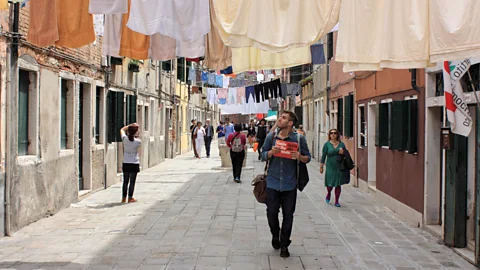 Matthias Scholz/Alamy Stock Photo
Matthias Scholz/Alamy Stock Photo5. Best for witnessing a slice of Venetian life: Corte Nuova
When many visitors think of Venice, they picture a gondolier paddling through canals, but Venetians think of laundry being hung to dry in the sun. "It's prohibited to hang your laundry out to dry in Venice in the [heavily touristed] sestiere of San Marco," said Mazzola. "You have to keep your laundry inside. But not in the other districts. In Castello, there's a street called Corte Nuova, and it's fantastic because every morning whenever it's sunny the women who live on this street hang out their laundry to dry. The street becomes multi-coloured."
Many Italian cities ban the practice of hanging laundry out to dry in touristy areas, but line drying laundry is one of the most Italian-core customs, even in romantic Venice, where you'll catch powdery whiffs of Marseille soap as you through the calle. "You see sheets, shirts, you see all the laundry, all the washing, and it's amazing. It's very famous," said Mazzola. "Castello is an area full of Venetians so it's part of daily life. If you go to San Marco, you won't hear anyone speaking Venetian. You'll hear German, English, Russian, Chinese. If you go to Castello, you'll hear Venetian."
 Catuncia/Getty Images
Catuncia/Getty Images6. Best for capturing the sunset: the Arsenale di Venezia
A bridge on the Grand Canal may be the best place in Venice to see the sunrise, but you'll see wonderful sunsets from the shore of the Arsenale di Venezia – the city's military zone. "That's also in the Castello district," said Mazzola. "Inside the Arsenale, the walls are closed and that's the military area of Venice where the Venetians once constructed warships. Nowadays, we have the military marina inside the Arsenale."
While a military zone may seem like a rather unromantic spot to experience the sunset, Mazzola explains: "It's because the sun sets behind San Marco. You go to get that shot of the last sun with a part of the Piazza San Marco with the tower. So, you see all the water, you see the start of the Grand Canal, on the right you see Piazza San Marco. And then you see the sunset.
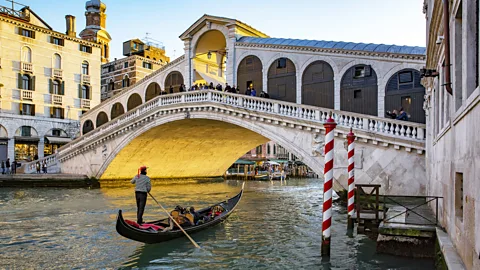 westend61/Getty Images
westend61/Getty Images7. Best classic Venice shot: the Rialto Bridge
Few images of Venice are as indelible as the stunning Rialto Bridge, with its steep pointed roof and graceful arches, curving over the Grand Canal. Rebuilt several times since the 12th Century, the current stone bridge has been a fixture in daily Venetian life since the late 1600s, and a magnet for every visitor to Venice since.
"If you go at 07:00 in the morning, you'll just find two people so you can take photos and it's nice," said Mazzola. "But if you go at noon or at [15:00] in the afternoon, you'll find 200 people taking selfies and in my opinion it's no longer enjoyable." He added wistfully: "The places are all marvellous. But to appreciate them you have to visit them at certain times of day."
BBC Travel's The SpeciaList is a series of guides to popular and emerging destinations around the world, as seen through the eyes of local experts and tastemakers.
---
more than three million BBC Travel fans by liking us on Facebook, or follow us on Twitter and Instagram.
If you liked this story, sign up for the weekly bbc.com features newsletter called "The Essential List". A handpicked selection of stories from BBC Future, Culture, Worklife and Travel, delivered to your inbox every Friday.
